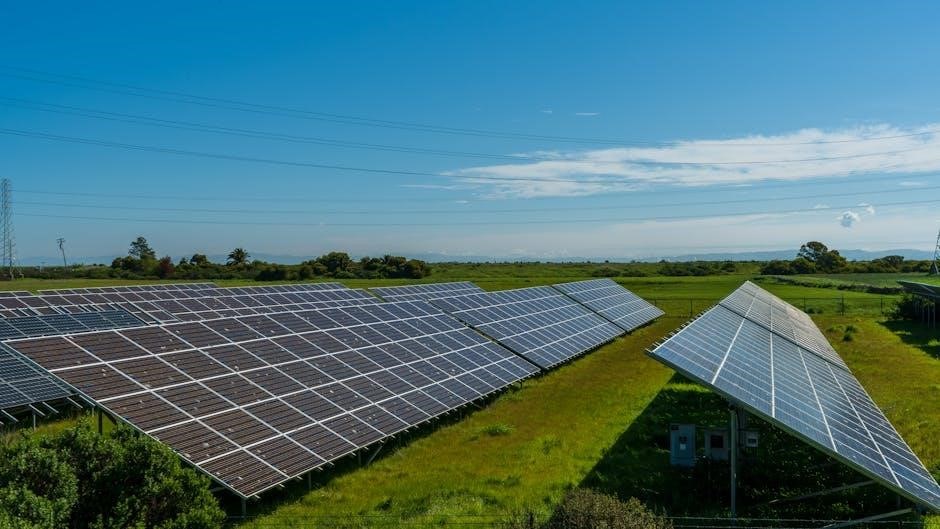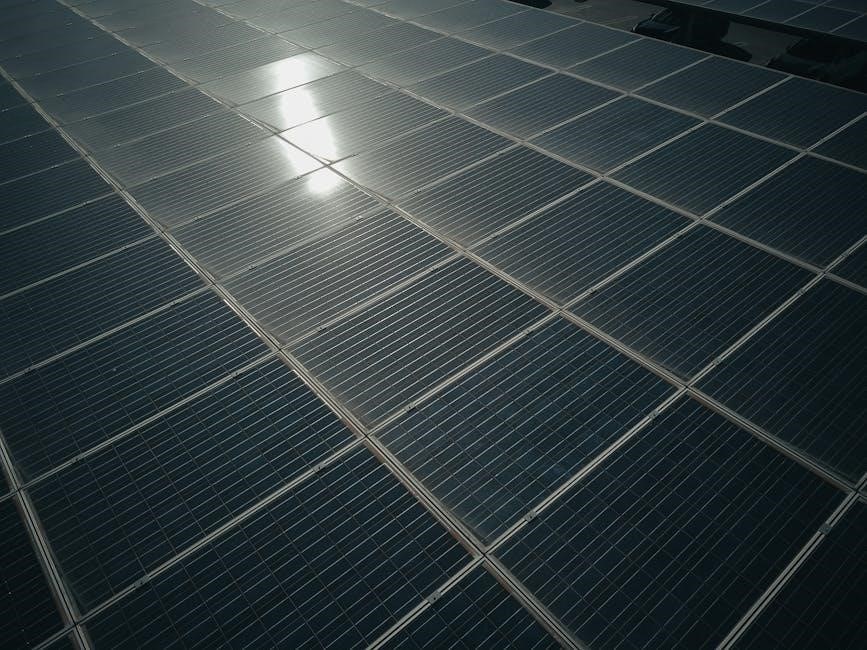
What is Solar Energy?
Solar energy, derived from the sun’s rays, is the Earth’s most abundant energy source․ Enough sunlight reaches the surface in just 1․5 hours to power
Definition and Abundance
Solar energy, the radiant light and heat from the sun, is harnessed using various technologies like photovoltaic (PV) panels․ Scientists have long recognized the sun’s immense energy output, making solar energy the most plentiful resource on our planet․ The Earth receives an extraordinary amount of solar radiation daily; in fact, just 90 minutes of sunlight contains enough energy to theoretically power the entire world for a year․ Solar energy is a renewable source, meaning it naturally replenishes, unlike fossil fuels․ Its availability and abundance make it a key player in transitioning to a sustainable energy future, reducing our reliance on finite and environmentally damaging resources․ The sun’s consistent energy delivery makes solar a dependable option for meeting global energy demands․
Environmental Benefits of Solar Energy
Harnessing solar energy offers significant environmental advantages, making it a cornerstone of sustainable energy production․ Unlike traditional fossil fuels, solar energy produces minimal greenhouse gas emissions during operation, mitigating climate change․ The solar industry actively offsets billions of tons of carbon dioxide emissions, contributing to cleaner air and a healthier planet․ Furthermore, solar energy systems consume little to no water during electricity generation, conserving precious water resources․ By reducing our reliance on fossil fuels, solar energy helps to decrease air and water pollution associated with extraction, processing, and combustion․ Solar energy promotes environmental stewardship, minimizing the negative impacts of energy production on ecosystems and human health․ Its role in fostering a cleaner, more sustainable future is undeniable․

How Solar Panels Work
Photovoltaic (PV) Effect
Solar panels generate electricity when sunlight strikes them, initiating the photovoltaic effect and causing an electric current to flow․
Photovoltaic (PV) Effect
Solar energy systems function by harnessing sunlight through solar photovoltaic modules (PV panels), triggering the flow of electric current․ This process begins when sunlight strikes the solar panel, which is composed of solar cells․ These cells, when combined, form a solar array․ For large-scale applications, numerous solar arrays are interconnected to create extensive utility-scale PV systems․ The current generated by the PV panels is regulated by an inverter, converting direct current (DC) into alternating current (AC), suitable for household appliances․ The efficiency of this conversion and the overall energy flow are critical for maximizing the value for ratepayers and ensuring efficient use of resources within the system․ A monitoring system is typically implemented to oversee the performance of the solar plus storage setup․
Components of a Solar Panel System
A solar panel system comprises several key components working in harmony to convert sunlight into usable electricity․ At the heart are the solar panels themselves, typically made from solar cells combined to form a solar array․ These panels capture sunlight and generate direct current (DC) electricity through the photovoltaic effect․ An inverter is essential for converting the DC electricity into alternating current (AC), which is the standard form used by household appliances and the electrical grid․ Additionally, a charge controller manages the energy flow to and from a battery storage system (if included), optimizing battery life and preventing overcharging․ Monitoring systems are also frequently integrated to track system performance, ensuring efficient energy production and identifying potential issues․ Finally, safety components, such as disconnect switches and fuses, are crucial for protecting the system and ensuring compliance with electrical codes․

Types of Solar Panels
Conventional solar panels are typically made from solar cells that, when combined together, create one system called a solar array․
Conventional Solar Panel Types
Understanding the different types of conventional solar panels is crucial when considering solar energy for your home or business․ Solar panels are typically made from solar cells that, when combined together, create one system called a solar array․ For large electric utility or industrial applications, hundreds of solar arrays are interconnected to form a large utility-scale PV system․ Deciding on the right type of solar panel depends on various factors, including your budget, energy needs, available space, and aesthetic preferences․ Each type offers unique advantages and disadvantages, and it’s essential to weigh these factors to make an informed decision that aligns with your specific requirements․ Solar energy is a significant investment, and choosing the right solar panels is key to maximizing its benefits and ensuring long-term performance and satisfaction․ So, before taking the leap, research and consult with solar professionals to determine the most suitable option for your energy goals․

Cost of Solar Panel Systems
Understanding factors affecting the system cost․ How much does a typical solar panel system cost? Do you intend to install a solar system?
Factors Affecting System Cost
Several factors influence the overall cost of a solar panel system․ These include the size of the system needed to meet your energy consumption, the type of solar panels chosen (e․g․, monocrystalline, polycrystalline, or thin-film), and the complexity of the installation․ Labor costs, permitting fees, and inspection costs also contribute to the final price․ Additionally, the cost of inverters, which convert DC electricity from the panels to AC electricity for household use, and battery storage systems, if included, will impact the total expense․ Geographic location plays a role, as different regions have varying labor rates and regulatory requirements․ Finally, the presence of financial incentives, such as tax credits, rebates, and grants, can significantly reduce the net cost of the system, making solar energy more affordable and accessible to homeowners and businesses․
Financial Incentives for Solar Installation
Numerous financial incentives are available to reduce the upfront cost of solar panel systems and accelerate the return on investment․ The federal government offers a significant tax credit for homeowners and businesses that install solar energy systems․ State governments often provide additional incentives, such as tax credits, rebates, and grants, which can further lower the cost․ Many utility companies also offer rebates or performance-based incentives for solar installations․ Net metering policies, where homeowners receive credit for excess electricity sent back to the grid, can also provide ongoing financial benefits․ Some states and municipalities offer property tax exemptions or reductions for properties with solar panels, further enhancing the financial attractiveness of solar energy․ These incentives vary by location and are subject to change, so it is essential to research the specific programs available in your area to maximize savings․
Solar Energy and Land Use
Generating 45% of US grid power via solar would require about 5 million acres, a small fraction of the 1․9 billion acres in the contiguous states․
Land Area Required for Solar Farms
To significantly ramp up solar energy generation, reaching levels such as 45% of the grid (approximately 900 gigawatts), land usage becomes a relevant consideration․ According to the U․S․ Department of Energy’s Solar Futures Study, achieving this level of solar energy production would necessitate approximately 5 million acres of land․ While this may seem like a substantial amount, it is important to contextualize it within the larger scope of land availability․ In the 48 contiguous states alone, there are nearly 1․9 billion total acres of land․ Therefore, the 5 million acres required for widespread solar energy deployment represents a relatively small percentage of the overall landmass․ Moreover, it’s worth noting that solar installations can often coexist with other land uses, such as agriculture or conservation efforts, further optimizing land utilization․ The development of solar farms should prioritize diligent practices to minimize environmental impact and ensure responsible land management, protecting ecosystems and promoting sustainable coexistence․ Careful planning and consideration of land use are crucial for maximizing the benefits of solar energy while minimizing potential disruptions․
Solar Energy and Electricity Generation
Solar energy’s contribution to electricity generation is growing․ In 2021, solar accounted for 3․9% of total electricity in the US, up from 0․7% in 2014․
Contribution of Solar to Total Electricity Generation
The utilization of solar energy for electricity generation is experiencing a significant upswing both within the United States and on a global scale․ Examining the statistics for the United States, solar energy accounted for approximately 3․9% of the total electricity generated in 2021․ This figure represents a notable increase compared to the 0․7% share recorded in 2014, highlighting the rapid growth and increasing adoption of solar power technologies․ This upward trend underscores the growing recognition of solar energy as a viable and sustainable alternative to traditional fossil fuels․ As technology continues to advance and costs associated with solar energy systems decrease, its contribution to the overall electricity mix is projected to further expand, playing an increasingly important role in meeting the world’s energy demands while mitigating environmental impact․
Solar Energy System Performance
PV systems generate electricity even when the weather is cloudy, but less than on sunny days․
Electricity Generation on Cloudy Days
Can PV systems produce power on cloudy days? While PV systems generate electricity even when the weather is cloudy, the amount of electricity produced is significantly reduced compared to sunny conditions․ Solar panels rely on sunlight to generate electricity through the photovoltaic effect․ When sunlight strikes the solar cells, photons (light particles) excite electrons, creating an electric current․ On cloudy days, the amount of sunlight reaching the panels is diminished due to cloud cover, which scatters and absorbs some of the sunlight․ The extent of the reduction in electricity generation depends on the thickness and density of the clouds․ Light, scattered clouds may only slightly reduce output, while dense, dark clouds can substantially decrease electricity production․ Despite the reduced output, solar panels still generate power on cloudy days; The energy produced can still contribute to offsetting electricity consumption and reducing reliance on the grid․ In addition, solar energy systems connected to the grid can draw power from the grid when solar generation is insufficient to meet demand, ensuring a continuous supply of electricity․
Safety and Regulations
A solar facility must comply with the National Electric Code, ensuring proper installation and safety․
Compliance with National Electric Code
Ensuring the safe and reliable operation of solar energy systems is paramount․ Compliance with the National Electric Code (NEC) is a critical aspect of this․ The NEC provides comprehensive standards for the installation of electrical systems, including solar photovoltaic (PV) systems․ These standards address various safety concerns, such as proper wiring methods, overcurrent protection, grounding, and disconnect requirements․ Adherence to the NEC ensures that solar installations are performed by qualified professionals and that the systems meet specific safety criteria, minimizing the risk of electrical hazards․ This includes ensuring proper equipment specifications, implementing safety procedures during installation, and adhering to established guidelines for electrical work․ Regular inspections and adherence to local codes further contribute to maintaining a safe solar energy environment, protecting both installers and end-users․ These regulations are in place to create a safe and reliable solar power infrastructure․

Solar Plus Storage Systems
Solar plus storage systems integrate battery storage to manage energy flow and maximize efficiency․
Battery Storage and Energy Management
Battery storage systems play a crucial role in optimizing the use of solar energy․ These systems store excess energy generated by solar panels during periods of high sunlight, allowing it to be used later when sunlight is limited or unavailable, such as during cloudy days or at night․ This ensures a more consistent and reliable energy supply, reducing reliance on the grid․ Energy management systems are integrated to control the energy flow amongst the solar panels, the battery storage system, and the grid․ They ensure that each resource is used efficiently and effectively, and that the battery system is charged and discharged in a way that maximizes value for ratepayers․ This integrated approach enhances the overall efficiency and reliability of solar energy systems, making them a more viable and sustainable energy solution․ Battery storage also enables greater energy independence, allowing homes and businesses to reduce their dependence on traditional power grids and lower their electricity costs․ Furthermore, it supports grid stability by providing backup power during outages and peak demand periods․ The combination of solar energy and battery storage represents a significant advancement in renewable energy technology, offering a pathway to a cleaner and more resilient energy future․
Monitoring System Functionality
A monitoring system is essential for tracking the performance of solar plus storage systems․ It provides real-time data on energy production, consumption, and storage levels, allowing users and system operators to assess the system’s efficiency and identify any potential issues․ The monitoring system tracks various parameters such as solar panel output, battery charge status, grid interaction, and overall system health․ This data enables informed decision-making regarding energy usage and storage strategies, optimizing the system’s performance․ Furthermore, the monitoring system can detect anomalies or malfunctions, such as decreased solar panel output or battery degradation, prompting timely maintenance and repairs․ This proactive approach ensures the system operates at its peak efficiency and prolongs its lifespan․ Advanced monitoring systems also offer remote access, allowing users to monitor their system’s performance from anywhere via web or mobile applications․ This provides convenience and peace of mind, knowing that the system is functioning optimally․ The data collected by the monitoring system can also be used for performance analysis and reporting, providing valuable insights for continuous improvement and optimization․ Ultimately, the monitoring system is a critical component of solar plus storage systems, ensuring their reliability, efficiency, and long-term sustainability․